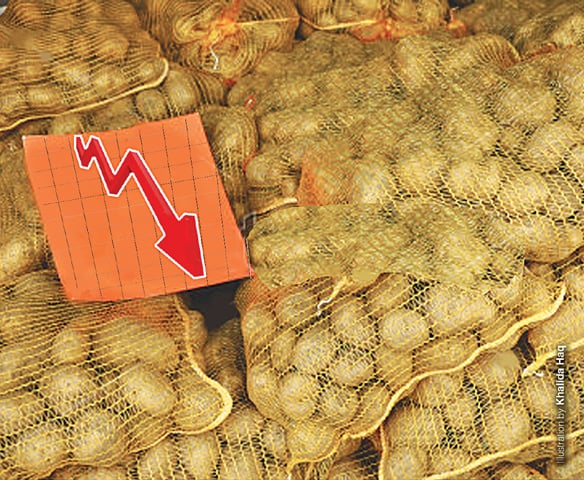 |
THE worst fears of potato growers in Punjab have started to come true. Total production of the crop has crossed the bumper level of 6m tonnes.
Prices, which dropped below the reported cost of production before the glut had hit the market, continue to tumble. The price for red skin variety is down from Rs15 per kg in mid-February to Rs11 currently. For white skin potato, they are even lower, ranging between Rs8-9 per kg. This is just more than half the cost of production.
Official efforts of slapping import duty and removing the levy on exports came much late. Export has started gaining some momentum, with over 30,000 tonnes already on the high seas to their foreign destinations. But the crucial question remains: would exports be able to absorb the glut? The answer is no.
The total domestic surplus, according to farmers, might be anywhere between 2.5-3m tonnes. The country has never been able to export more than 100,000 tonnes, and has averaged at around 80,000 tonnes. And these figures were achieved during regional shortages, when crops in winter potato producing countries (Bangladesh and India) had failed.
This year, both these competitors have their own surpluses and would compete with Pakistan for foreign markets’ share.
The total domestic surplus, according to farmers, might be anywhere between 2.5-3m tonnes, and the country has never been able to export more than 100,000 tonnes
Better tuber quality gives Pakistan an edge, but it remains to be seen if this advantage is exploited or not. Thus, in all probability, a huge quantity of the crop would remain within the country.
The government has faced a lot of criticism for delaying decisions on import and export duties this year. In fact, the official circles were torn between two opposing views. One of them wanted to let the prices crash and draw political mileage out of the lower prices. They believed that growers had made a lot of money last year when prices had skyrocketed.
The other one, taking a long-term view of the crop, wanted to promptly remove the duties to help maximise exports. Ultimately, the duties were removed in January when early harvesting had already hit the market and a massive surplus was clearly written on the wall.
Official circles also need to realise that the potato crisis might not go away next year and even after that. The imported seed, which costs fortunes in agricultural terms, allows a 4-5 times increase in acreage. Pakistan’s last five-year average of seed imported from Holland stood at 8,500 tonnes. This year, it almost doubled to 16,000 tonnes.
These 16,000 tonnes would probably add another 100,000 acres next year. This crop yields over 400 maunds per acre. The farmers thus go for it even in bad conditions. Therefore, the trend of over-production and lower prices is bound to hold, unless climate fails the crop.
The Far East and the Middle East are two potential markets that must be looked at. China has dominated the Far East market, where some niche can be created. The Malaysian market, where Pakistan has had a substantial presence, provides the model that could be replicated for other regional markets.
The Middle East, even with its limited population, still provides a huge market for two reasons. The first is the purchasing power of the people, and the second is that Saudi Arabia has stopped its own production because of a water squeeze. The Egyptians, who had traditionally been feeding the Saudis, have had their own share of problems. These two markets need special attention of Pakistani policy planners.
The farmers and exporters agree that, if handled with care, both these regions could easily double, or even triple, Pakistan’s potato exports within a span of a few years.
Meanwhile, China, despite being the biggest producer of potato in the world, plans to invest in another million hectares of the crop over the next five years. It has rewritten domestic recipes, where potato was historically missing, keeping in mind the nutritional value of the crop, and for meeting the food requirements of the population. Apart from promoting domestic consumption, it also plans to export more to regional markets.
Pakistan, fortunately, is ahead of China because it has ready surpluses and the possibility of sustaining them is also very high. These surpluses need to be connected to foreign markets, wherever possible.
Published in Dawn, Economic & Business, March 9th, 2015
On a mobile phone? Get the Dawn Mobile App: Apple Store | Google Play














































Dear visitor, the comments section is undergoing an overhaul and will return soon.